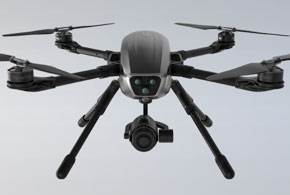Built with a high-quality Panasonic Lumix G camera lens for cinematography-quality video, the drone will be available in December.
The PowerEye Professional drone, now available for preorder, is aimed at filmmakers who want to shoot high-quality 4K HD video with pinpoint control and fine optics.
Geared for professional cinematographers, the drone is priced at $3.988 and will be available for delivery in December, the company announced on Sept. 29. Equipped with a standard Panasonic Lumix G 14mm F2.5 aspherical pancake lens, the PowerEye Professional drone debuted at the Interdrone conference in Las Vegas in September.
The drone is built for dual control, which allows a pilot to handle the flight duties while a second person captures high-quality video, using separate cameras to monitor the flight and the creative video being shot. A stationary First Person View camera is mounted on the front of the drone for the pilot’s use, while a gimbal-mounted, fully adjustable high-quality camera below can be aimed by the second operator as they video their subject. A dual-view image of both cameras is available to the operators.
The dual viewing can be managed by a single person using one mobile device in either a split screen or picture-in-picture mode using a PowerEye app, or two people can each use the dual-view mode using two mobile devices with one managing the stationary camera, and the other managing the movable camera.
Six optional lenses are also available for the drone, giving users a choice of optics for videography. Global preorders are being taken for the craft on the company’s PowerVision online store.
The PowerEye Professional four-rotor drone also includes built-in object-detection technology, which uses an array of integrated sensors to detect flight path obstacles and sound an alert within 32 feet to avoid collisions with trees, buildings, power lines and other obstructions. The 8.7-pound drone can transmit video for up to 3.1 miles away and has a maximum flight time of 29.5 minutes, under current Federal Aviation Administration rules. It can carry a maximum payload of up to 6.6 pounds. The device is portable and folds up into a 13.4-inch by 11.2-inch by 11.65-inch size. The craft has retractable folding landing gear to accommodate take-offs and landings on a wide variety of surfaces
The drone comes with a full set of propellers, the Panasonic Lumix G 14mm F2.5 lens, a rolling carrying case, one remote control, one extra pair of propellers, a base station, a battery and a battery charger. Preorder buyers who pay for the device in advance will also receive a bonus additional remote control, which is valued at $199.
Chih-Che Tsai, CEO of PowerVision Robot Corp., told eWEEK that the availability of two cameras for the use of the pilot and videographer in the PowerEye Professional drone adds flexibility for users. “You don’t see this in most of the high-end drones on the market right now,” he said.
The company also offers a consumer drone, the $1,288 PowerEgg, which became available for preorder starting in August and will ship in November. Uniquely shaped like an egg standing on its end, the PowerEgg uses a one-handed, gesture-based remote control for its operations, rather than a traditional video game-like controller.
“People always think drones are quad-copters,” said Tsai. “We don’t.”
The PowerEgg is for “everyone who has never flown a drone,” he said. “You don’t need two-handed controls anymore. You use just a gesture. You move your arm forward, and it goes forward.”
Another version of the PowerEye Professional drone is also available with a thermal imaging camera mounted below for users who require thermal imaging. Pricing for the thermal imaging model depends on the buyer’s desired configuration.
In June, the Federal Aviation Administration’s long-awaited commercial drone rules were finalized to allow businesses to use drones weighing up to 55 pounds for aerial photography, agricultural work, construction surveying and other for-hire uses, but related rules that could allow package delivery are still not ready.
In the last few years, while the FAA was working to create final operating rules for commercial drones, companies were able to apply for “exemptions” under FAA Section 333 rules that allowed them to perform work using drones, even as the rules were being written and before they were finalized. Almost 2,000 such exemptions were approved by the FAA while the rules were being drafted, allowing businesses to begin operations with drones as the technology emerged.
Under the new rules, commercial drone operators will now have to have a remote aircraft certificate with a small unmanned aircraft system (UAS) rating, or be supervised by someone holding such a certificate, instead of needing a higher-level pilot’s license, according to the FAA.
The FAA had been working since 2012 to develop rules and procedures for the commercial use of drones. The regulations are needed to govern drone flights and keep them safely away from commercial and private aircraft traffic as well as pedestrians and other hazards on the ground.
A wide range of businesses, from e-retailer Amazon to agricultural businesses, photographers, energy production companies, news operations and others have been clamoring for the ability to use drones for several years, but have been prevented from doing so until the new rules were adopted. The companies argued that delays in implementing drone rules in the United States have kept businesses from benefiting from cost savings and new revenue from their use.

![[Video] Samsung Outlines AI Vision at The First Look 2026](https://loginby.com/itnews/wp-content/uploads/2026/01/Video-Samsung-Outlines-AI-Vision-at-The-First-Look-2026-238x178.jpg)
![[Video] An Exclusive Look at Galaxy XR With the Engineers](https://loginby.com/itnews/wp-content/uploads/2025/10/Video-An-Exclusive-Look-at-Galaxy-XR-With-the-Engineers-238x178.jpg)




